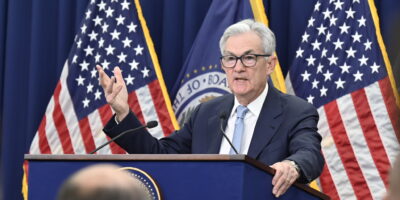Thoughts on Jefferson and the Dollar at Monticello
The following speech was given by Dr. Judy Shelton on January 30th, at the Jefferson Library in Thomas Jefferson’s Monticello:
[Dr. Shelton] Thank you very much, very pleased to be here.
It’s an honor to be introduced by Andrew O’Shaughnessy…
I taught with your father, who is professor emeritus at the graduate business school at Columbia and was also at Cambridge. So that’s a nice coincidence. But I was already enthused to meet you because I had been so impressed with your book…”The Men Who Lost America”…it tells of our Revolution from the British point of view…and I’m hoping you will sign my copy, which I brought with me…
Being here at Monticello with you all is just a wonderful experience in itself. My husband, Gil, and I took the private tour this afternoon…and what a privilege to meet the people who make all this possible through the Thomas Jefferson Foundation, who have ensured through their vision and commitment that Mr. Jefferson’s talents, ideals and ambitions – which are reflected in the design and architecture of Monticello itself – are not only protected and preserved here physically…they are also shared across an intellectual spectrum that spans America and the world.
I took a look at the Mission Statement for the Thomas Jefferson Foundation. It is a very inspiring – yet concise – document: That in itself is a tribute to Thomas Jefferson. The Mission Statement says that the Foundation seeks to “engage a global audience in a dialogue with Jefferson’s ideas, the most powerful of which are liberty and self-government, and to excite the world about Jefferson’s relevance today.”
Very compelling…
And I might note that our own mission at the Atlas Economic Research Foundation dovetails with that objective as we strengthen the worldwide freedom movement by helping to support a network of more than 400 independent organizations in 85 countries, all working to advance the cause of liberty grounded on a vision of limited government, rule of law, and free markets.
That’s the vision handed down to us by our Founding Fathers…the idea behind this great American experiment in self-government based on personal freedom and responsibility.
We could have a debate, no doubt, about whether that experiment is continuing to play out in full accordance with what the Founders had in mind.
But having served on the Board of the National Endowment for Democracy these past nine years…I can testify that the American Idea still inspires brave individuals around the world. Because I have met with pro-democracy activists, opposition leaders…from Russia, Ukraine, Cuba, Iran…and had them say to me, you know, what’s great about the U.S. Constitution is that it starts out with the words: “We the people….”
And that’s a pretty sobering reminder…that “we the people” have to ensure that we continually monitor the role of government in our society, and that we are cognizant when government intrudes on personal freedoms. As an economist, I feel it’s necessary to identify where government influence encroaches on free-market mechanisms…and distorts economic outcomes…which can result in doing grave damage to the vision of our Founding Fathers by undermining the morality of democratic capitalism.
In 1994, twenty years ago, I wrote a book called “Money Meltdown” while I was out at Stanford at the Hoover Institution. Then and now, I was very concerned about the ability of central banks to compromise the integrity of money. Now, of course, the biggest, most dominant central bank is our own – the Federal Reserve. America’s central bank largely drives monetary policy for the world. And the Fed has come to show little regard for preserving the reliability of the dollar.
And this seems an anomaly. How did this happen? How did the value of the dollar – the U.S. money unit — come to be subjugated to the wholly discretionary authority of a dozen individuals, the members of the Federal Open Market Committee, who meet eight times a year in Washington to define or redefine America’s monetary policy…most recently yesterday.
How is it that a nation dedicated to limited government and self-rule turns over to an agency of government the power to determine the value of our nation’s money unit?
A critically important function of money, speaking as an economist (but you all know this), is to serve as a measure — a meaningful unit of account. Money is also meant to provide a reliable store of value. The money unit is arguably the most fundamental component of finance.
If you’ll pardon the indulgence of quoting from one of my own op-eds for the Wall Street Journal, published in September 2008 — the day after the meltdown in financial markets when the Dow lost nearly 800 points, its biggest one-day point drop ever…
In that piece, I emphasize the importance of the money unit by saying:
“Money is the medium of exchange – the measure, the standard, the store of value – which defines the very substance of the economic contract between buyer and seller. It is the basic element, the atom of financial matter. It is the money that’s broken.”
Which leads us back to the question: How did the money unit of a nation founded on “rule of law” come to be turned over to the rule of men…?
(Or women.)
I’m not questioning the benevolent intentions of Ben Bernanke or Janet Yellen…who would like nothing better than to reduce unemployment. But I would contend that the good intentions of government do not trump what individuals can accomplish on their own, under conditions of freedom and rule of law. I think we should have learned that from the Soviet experiment in central planning.
Our country was based on the notion that people are capable of making rational economic decisions in their own best interests. Our Founders sought to establish America’s money in terms worthy of the American idea – consistent with the concept that the purpose of government is to secure the rights of life, liberty, and the pursuit of happiness for its citizens…by defending the rule of law, private property and free markets. A reliable unit of measurement is imperative for all that; it all rests on a sound money foundation.
If only we knew what Thomas Jefferson would have recommended with regard to establishing the money unit for this new country, this new idea, this new concept of civil society based on individual freedom?
It seems a gift of providence that a hand-written document, specifying exactly what Mr. Jefferson thought about how to define America’s money, exists. I will always be grateful to the Atlas Economic Research Foundation – to its farsighted Board, its management and staff, its donors – for taking on the project of properly publishing this marvelous 12-page document in a way that permits us to appreciate Jefferson’s particular genius for melding common sense with profound insight. The assistance of Gonzalo Schwarz has been invaluable. And thanks, too, to my wonderful colleague, Alex Chafuen. And Chelsea Albers. And Kristina and Kelly.
There is something very personal and touching about reading Thomas Jefferson’s own handwriting, seeing his underlined words and his cross-outs, noting his mathematical calculations, discerning the pragmatic aspects of his elegant logic. It’s like watching the man’s mind at work.
It was the willingness of the Library of Congress – which has the original document — to work with us by providing these high-resolution, warm-toned photographic images of Jefferson’s twelve pages…that made this book possible. Gonzalo Schwarz, Chelsea Albers, my colleague and co-director for the Sound Money Project, Alex Chafuen, all played invaluable roles. And together with the illustrations graciously provided by the Thomas Jefferson Foundation at Monticello, this book really invites the reader to take a walk with Mr. Jefferson as he lays out his analysis and recommendations. It humanizes the very serious business of establishing a money unit for a new nation.
There are many things about this document that strike me as remarkable. One is the fact that Jefferson…a highly-literate, politically-minded man, who served in the Continental Congress and as a wartime governor of Virginia…he employs here the language of an economist, using the term “money unit.” The first line of the first page defines the challenge Jefferson proceeds to address in this document. It starts out: “Notes on the Establishment of a Money Unit…” as in: unit of account.
Now, these pages are often referred to as Jefferson’s “Notes on Coinage”…but I think that elevates the secondary aspect of this document over its more fundamental purpose. Which is to explain why Jefferson thinks the United States should establish a money unit that serves primarily the interests and pursuits of common Americans — merchants, farmers, manufacturers. Not one that just caters to the financial elite, who certainly existed in those days, and who were lobbying for a more complex, more sophisticated approach to money and finance.
Jefferson’s argument as laid out here…is that the money unit has to work for everyone. It should be straightforward, simple, trustworthy.
Jefferson writes (quote):
“In fixing the Unit of money (he capitalizes “Unit”), these circumstances are of principal importance:
I. That is be of convenient size (underlined) to be applied as a measure to the common money transactions of life.
II. That its parts and multiples be in an easy proportion (underlined) to each other, so as to facilitate the money arithmetic…and
III. That the Unit and its parts, or divisions be so nearly of the value of some of the known coins as that they may be of easy adoption for the people.”
So America’s money unit must be convenient, easy-to-use, and familiar, so that people can comprehend this measure of value in a meaningful way. The money should serve the people…it should facilitate the arithmetic needed to carry out the common money transactions of life.
Jefferson demonstrates here his basic respect for individuals by not wanting to burden them with needlessly complicated formulas for measuring value. He proposes that America’s money should be based on the decimal system. It’s the first time any nation adopted such an approach. Jefferson says here that we should establish the basic money unit as a measure – and it should then be readily divisible into one-tenth and one-hundredth of that measure. And you could also multiply it by ten, or by a hundred, or a thousand…because having such a range would make it easier to deal with most of the money transactions in life. The main thing is to get the size of that core money unit right.
As Jefferson puts it:
“The expediency of attending to the size of the Money Unit will be evident to anyone who will consider how inconvenient it would be to a manufacturer or merchant, if, instead of the yard for measuring cloth, either the inch or the mile had been made the Unit of measure.”
Note Jefferson’s primary concern, once again, is that the money serve the interests of the manufacturer or merchant…working Americans.
Why is Jefferson so insistent on this point? Ahh…because a competing proposal for defining America’s money unit was being pushed rather aggressively by Robert Morris, who had been appointed Superintendent of Finance at the Treasury, a very powerful position. Morris wanted to adopt a money unit for the United States derived through a least-common-denominator approach that would mathematically accommodate down to the penny all the different currencies in circulation among the 13 states. The Morris plan relied on a rather ingenious formula that could be expressed as a matrix across the varying rates of exchange between foreign currencies and across state lines…to facilitate the collection of funds paid into the national treasury based on this elaborate calculation.
One big problem, though. For the formula to work, you would have to define the money unit as being divisible into 1440 parts.
Now Jefferson’s main motivation for writing this document was probably the fact that we were edging toward the plan put forward by Morris, whom he refers to in these notes as “the Financier” (not with rancor, but that description does hint at a more elitist perspective)…
Jefferson acknowledges near the bottom of page 4 that the Financier has conceived a worthy proposal…but based on what Jefferson stipulated at the beginning of his own notes as being principally important, that the money unit be convenient and easy to use…the Morris approach is just “defective” (Jefferson’s word).
Very endearingly, in my view, Jefferson explains here that, look, we’re all school boys when it comes to these accounting perplexities of adding the farthings, carrying the shillings, subtracting the pence…he writes (quote): “Even mathematical heads feel the relief of an easier substituted for a more difficult process.”
And besides, Jefferson adds, since “our object is to get rid of those currencies,” why would you forever encumber the nation with the inconveniences of a money unit defined in such terms?
In other words: Keep it simple.
Jefferson offers an example. He asks, would you rather calculate the value of a horse or bull a being worth 80 dollars…the term dollar here referring to the Spanish dollar, one of the most common coins used in America…or would you rather establish, in accordance with the Morris plan, a new money that would express the equivalent of 80 dollars as 115, 200 units.
“As a money of account,” Jefferson writes, “this will be laborious…and as a common measure of the value of property it will be too minute to be comprehended by the people.”
Now the French may put up with that kind of a money system, Jefferson notes – on page 5, he writes: “The French are subjected to very laborious calculations, the Livre being their ordinary money of account, and this but between 1/5 and 1/6 of a dollar. But what will be our labours, should our money of account be 1/1440th of a dollar?”
Bottom line, Jefferson recommends against instituting an esoteric money unit. He says instead, let’s embrace one that people already understand and use: the silver dollar.
And toward that end, here’s my favorite line in the whole document:
Jefferson says this: “If we determine that a dollar shall be our unit we must then say with precision what a dollar is.”
Why precision? There were many different silver dollars circulating among the states – issued by different countries, in different years – and the weight and fineness of their silver content varied. When it came to weights and measures, Jefferson was a firm believer in precision. He revered Sir Isaac Newton – who is mentioned four times in these notes.
Based on Jefferson’s recommendations as laid out here…the Coinage Act of 1792 would define America’s dollar in terms of precise weights: 371.25 grains of pure silver or 24.75 grains of pure gold.
The idea being: Precision, dependability, transparency…whether in establishing the standard of weights and measures for a nation, or for establishing its monetary standard, its money unit – will yield very positive social, political, economic and scientific results. Jefferson believed that reliable, well-defined standards would empower citizens to make responsible decisions for themselves and for the nation. And he hoped America’s standards…like her founding vision…would one day become universal.
Which is what we might expect from the man whose belief in democratic self-government helped define our nation.
Thank you so much, I’m grateful for the opportunity to speak with you tonight.











